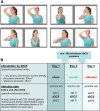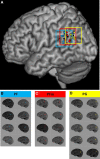Transcranial direct current stimulation (tDCS) of left parietal cortex facilitates gesture processing in healthy subjects
- PMID: 24305816
- PMCID: PMC6618775
- DOI: 10.1523/JNEUROSCI.4714-12.2013
Transcranial direct current stimulation (tDCS) of left parietal cortex facilitates gesture processing in healthy subjects
Abstract
Gesture processing deficits constitute a key symptom of apraxia, a disorder of motor cognition frequently observed after left-hemispheric stroke. The clinical relevance of apraxia stands in stark contrast to the paucity of therapeutic options available. Transcranial direct current stimulation (tDCS) is a promising tool for modulating disturbed network function after stroke. Here, we investigate the effect of parietal tDCS on gesture processing in healthy human subjects. Neuropsychological and imaging studies suggest that the imitation and matching of hand gestures involve the left inferior parietal lobe (IPL). Using neuronavigation based on cytoarchitectonically defined anatomical probability maps, tDCS was applied over left IPL-areas PF, PFm, or PG in healthy participants (n = 26). Before and after tDCS, subjects performed a gesture matching task and a person discrimination task for control. Changes in error rates and reaction times were analyzed for the effects of anodal and cathodal tDCS (compared with sham tDCS). Matching of hand gestures was specifically facilitated by anodal tDCS applied over the cytoarchitectonically defined IPL-area PFm, whereas tDCS over IPL-areas PF and PG did not elucidate significant effects. Taking into account tDCS electrode size and the central position of area PFm within IPL, it can be assumed that the observed effect is rather the result of a combined stimulation of the supramarginal and angular gyrus than an isolated PFm stimulation. Our data confirm the pivotal role of the left IPL in gesture processing. Furthermore, anatomically guided tDCS of the left IPL may constitute a promising approach to neurorehabilitation of apraxic patients with gesture processing deficits.
Figures



Similar articles
-
Modulating the assessment of semantic speech-gesture relatedness via transcranial direct current stimulation of the left frontal cortex.Brain Stimul. 2017 Mar-Apr;10(2):223-230. doi: 10.1016/j.brs.2016.10.012. Epub 2016 Oct 25. Brain Stimul. 2017. PMID: 27815051
-
Transcranial Direct Current Stimulation Improves Semantic Speech-Gesture Matching in Patients With Schizophrenia Spectrum Disorder.Schizophr Bull. 2019 Apr 25;45(3):522-530. doi: 10.1093/schbul/sby144. Schizophr Bull. 2019. PMID: 30304518 Free PMC article.
-
Left inferior parietal dominance in gesture imitation: an fMRI study.Neuropsychologia. 2005;43(7):1086-98. doi: 10.1016/j.neuropsychologia.2004.10.004. Epub 2005 Jan 5. Neuropsychologia. 2005. PMID: 15769494 Clinical Trial.
-
Non-invasive brain stimulation in limb praxis and apraxia: A scoping review in healthy subjects and patients with stroke.Cortex. 2021 May;138:152-164. doi: 10.1016/j.cortex.2021.02.006. Epub 2021 Feb 17. Cortex. 2021. PMID: 33691224
-
Apraxia, pantomime and the parietal cortex.Neuroimage Clin. 2014 Jun 5;5:42-52. doi: 10.1016/j.nicl.2014.05.017. eCollection 2014. Neuroimage Clin. 2014. PMID: 24967158 Free PMC article. Review.
Cited by
-
Anodal tDCS over left parietal cortex expedites recovery from stroke-induced apraxic imitation deficits: a pilot study.Neurol Res Pract. 2019 Nov 26;1:38. doi: 10.1186/s42466-019-0042-0. eCollection 2019. Neurol Res Pract. 2019. PMID: 33324903 Free PMC article.
-
The Lateral Occipito-temporal Cortex Is Involved in the Mental Manipulation of Body Part Imagery.Front Hum Neurosci. 2017 Apr 11;11:181. doi: 10.3389/fnhum.2017.00181. eCollection 2017. Front Hum Neurosci. 2017. PMID: 28443011 Free PMC article.
-
Using multi-level Bayesian lesion-symptom mapping to probe the body-part-specificity of gesture imitation skills.Neuroimage. 2017 Nov 1;161:94-103. doi: 10.1016/j.neuroimage.2017.08.036. Epub 2017 Aug 16. Neuroimage. 2017. PMID: 28822751 Free PMC article.
-
Hand-independent representation of tool-use pantomimes in the left anterior intraparietal cortex.Exp Brain Res. 2016 Dec;234(12):3677-3687. doi: 10.1007/s00221-016-4765-7. Epub 2016 Sep 3. Exp Brain Res. 2016. PMID: 27591782
-
Nonverbal communication remains untouched: No beneficial effect of symptomatic improvement on poor gesture performance in schizophrenia.Schizophr Res. 2020 Sep;223:258-264. doi: 10.1016/j.schres.2020.08.013. Epub 2020 Sep 1. Schizophr Res. 2020. PMID: 32883557 Free PMC article.
References
MeSH terms
LinkOut - more resources
Full Text Sources
Other Literature Sources
